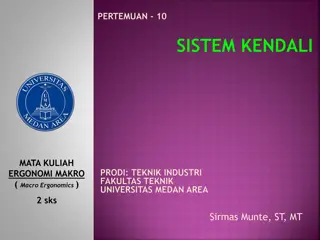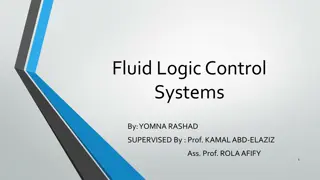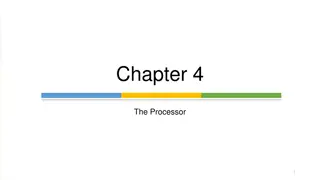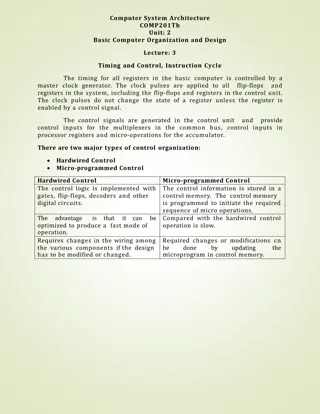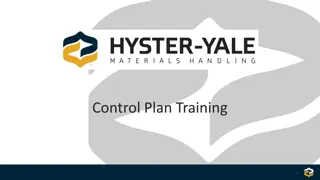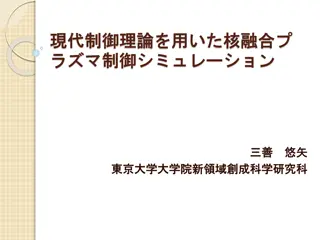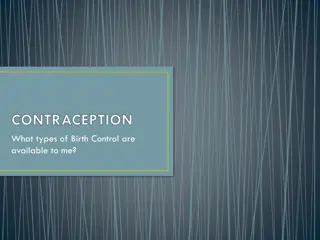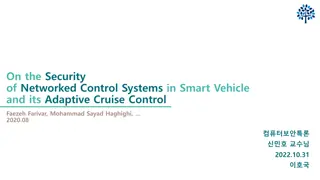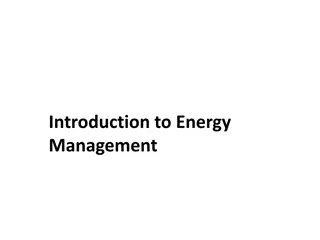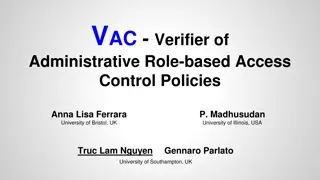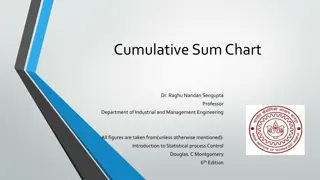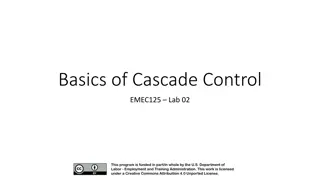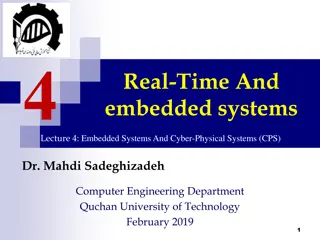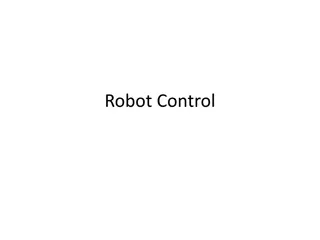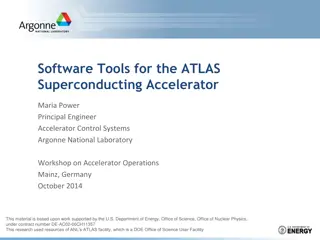Process Control Methods and Systems Overview
Process control involves different methods such as open-loop and closed-loop control systems to ensure a controlled variable remains at a desired set-point. Open-loop systems operate without feedback, while closed-loop systems are more effective by incorporating a feedback loop for self-regulation. Factors like disturbances, varying loads, and set-point adjustments can impact the behavior of a process. Additionally, single-variable control loops are used in production machines, each consisting of measuring devices, transducers, controllers, and final control elements. Response time of instruments is critical, affected by factors like sensor response time, signal travel distance, and processing time of the controller.
Download Presentation

Please find below an Image/Link to download the presentation.
The content on the website is provided AS IS for your information and personal use only. It may not be sold, licensed, or shared on other websites without obtaining consent from the author.If you encounter any issues during the download, it is possible that the publisher has removed the file from their server.
You are allowed to download the files provided on this website for personal or commercial use, subject to the condition that they are used lawfully. All files are the property of their respective owners.
The content on the website is provided AS IS for your information and personal use only. It may not be sold, licensed, or shared on other websites without obtaining consent from the author.
E N D
Presentation Transcript
Open-Loop Control Processcontrol operations are performed automaticallyby either open-loop or closed-loop systems Processes controlled only by set-point commands without feedbackare open-loop Open-loop systems are used in applications where simple processes are performed Open-loop systems are relatively inexpensive 2
Closed-Loop Control Closed-loop control systems are more effective than open- loop systems With the addition of a feedback loop they become self-regulating Components of a closed- loop system include: The primary element - sensor The controlled variable The measured variable The control signal The final correcting element 3
Process Behavior The objective of process control is to cause a controlled variable to remain at a constant value at or near some desired set-point The controlled variable changes because of: A disturbance appears Load demands vary Set points are adjusted 4
Process Behavior Example Flow throughthe pipe is the process Fluid flow rate is the controlled variable Valve position is the set point Demandfor the fluid downstream is the load Variance in upstream pressure is the disturbance 5
Single-Variable Control Loop Several process variables are controlled at once in a typical production machine Usually, only one individualfeedback loop is required to control each variable Single-variablecontrol loops consist of the following elements: Measuring device Transducer/transmitter Controller Final Control Element 6
Response Time of the Instrument Factors affecting lag: Response time of sensor Time lag of transducer Distance the signal must travel Time required for the controller to process Distance control signal must travel Time lag of the final correcting element All instrumentshave a time lag - the time from when a variable is measuredtill the corrective action is taken 7
Time Lag The controlled variable itself may contribute to lag problems because of inertia in the variable Lag due to inertia of the variable is referred to as pure lag Another factor that affects time lag is dead time - this is the elapsed time from when the deviation occurs and corrective action takes place 8
Selecting a Controller The controller mode selection is based upon the requirements of the process and one of the following control modes will be used: On/Off Proportional Integral Derivative 10
On-Off Control Used for slow acting operations where lag is unavoidable Final correcting element is either fully-on or fully-off The primary drawback of on-off control is the rapid switching of the final control element On-off differential or hysteresis is programmed into the controller Deadbandrefers to the differing levels at which a controller switches on and off 11
Continuous Control On/Off control is acceptable for processwhere the variable is set between two limits For processes where the variable needs to be kept at particularsetpoint level, proportional control is used Proportional action can be accomplished in two ways: Time ProportioningMethod Amplitude Proportional Method 12
Time Proportioning Is a method whereby the output of the controller is continually switched on and off On versus off times are varied dependent upon process requirements 13
Amplitude Proportional Most common technique to produce a proportional signal The control signal is proportional in amplitude to the error signal The signal may be amplified and the amplification may be referred to as proportional gain and proportional band 14
Proportional Gain Comparison Level control at a gain of 1 15
Proportional Gain Comparison (Gain set at 2) 16
Proportional Band Proportional band is defined as the percentage change in the controlled variable that causes the final correcting element to go through 100 percent of its range Controlled Variable % Change Final CorrectingElement % Change PB = 17
Integral Control Because of the introduction of offset in a control process, proportional control alone is often used in conjunctionwith Integral control Offset is the difference between set point and the measured value after corrective action has taken place 18
Reset Action Integral control is also referred to as reset control as the set point is continuously reset as longas an error is present Integral adjustments that affect the outputare labeled 3 ways: Gain - expressed as a whole number Reset - Expressed in repeats per minute Integral Time - Expressed in minutes per reset 19
Derivative Mode For rapid load changes, the derivative mode is typically used to prevent oscillation in a process system The derivative mode responds to the rate of change of the error signal rather than its amplitude Derivative mode is never used by itself, but in combination with other modes Derivative action cannot remove offset 20
Tuning the Controller Fine-tuning is the process to optimize the controller operation by adjusting the following settings: Gain setting (proportional mode) Reset rate (integral mode) Rate (derivative mode) Three steps are taken when tuning a systems Study the control loop Obtain clearance for tuning procedures Confirm the correction operation of the system components 22
Trial-and-Error Tuning Does not use mathematical methods, instead a chart recorder is used and several bump tests are made in the proportional and integral modes Trial-and-error tuning is very time consuming and requires considerable experience on the part of the technician or operator 23
Ziegler-Nichols Tuning Methods Two formal procedures for tuning control loops: Continuous cycling method Reaction curve method 24
Continuous Cycling Method The continuous cycling method analyzes the process by forcing the controlled variable to oscillatein even, continuous cycles The time duration of one cycle is called an ultimate period. The proportional setting that causes the cycling is called the ultimate proportionalvalue These two values are then used in mathematicalformulas to calculate the controller settings 25
Continuous Cycle Calculations Proportional only controller Proportional Gain Kc= Gux 0.5 KC= proportional gain, Gu= ultimate gain Proportional Band PB = Pbux 2 PB = proportional band Pbu= ultimate proportional band 26
Ziegler-Nichols Reaction Curve Tuning Method This method avoids the forced oscillations that are found in the continuous cycle tuning method Cycling should be avoided if the process is hazardous or critical This method uses step changes and the rate at which the process reacts is recorded The graph produces three different values used in mathematicalcalculations to determine the proper controller settings 28
Direct Synthesis Method The direct synthesis method uses the same procedures to analyze the process times as the Ziegler-Nichols reaction curve method One advantage of this method is that it directly matches (synthesizes) synthesizes the process The first step in this method is perform a bump test and recording the dynamic settlingtime Depending upon the complexityof the process, one of several dynamic response signalsmay develop as shown on the right 30
Advanced Control Techniques Some complex manufacturing operations require more precise control than available with PID controllers Four Techniques frequently used are: Cascade control Feed forward control Ratio control Adaptive control 32
Cascade Control Cascade control systems use a second feedback loop with a separate sensor and controller Cascadecontrol is effective in overcoming lag in some systems 33
Feedforward Control Feedforward control measures a variable that enters a process and takes corrective action if it is affected by a disturbance, reducing or eliminating deviation from the set point 34
Ratio Control Used in mixing systems where an uncontrolled flow of material (wild flow) is monitored and used to control the second material which is controlled according to the desired ratio between the two components 35
Adaptive Control To accommodate a nonlinear process, a microelectronic controller uses software that has adaptive control capabilities to compensate for nonlinear transducers and sensors 36
END 37
This workforce solution was funded by a grant awarded by the U.S. Department of Labor s Employment and Training Administration. The solution was created by the grantee and does not necessarily reflect the official position of the U.S. Department of Labor. The Department of Labor makes not guarantees, warranties, or assurances of any kind, express or implied, with respect to such information, including any information on linked sites and including, but not limited to, accuracy of the information or tis completeness, timeliness, usefulness, adequacy, continued availability, or ownership. This work by Mineral Area College is licensed under the Creative Commons Attribution 4.0 International License.



